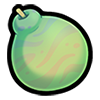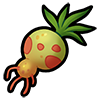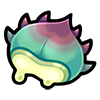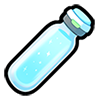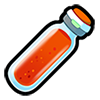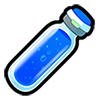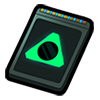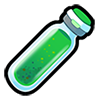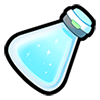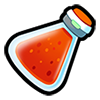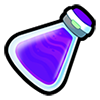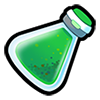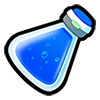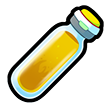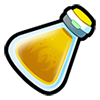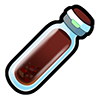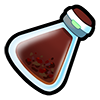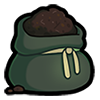Items
Tato Fruit
This beautiful fruit's dark purple juice is often used to create ink for many different purposes, but the fruit's claim to fame is its wide-spread use for creating tattoo ink. Even the fruit's skin has a similar texture to that of many sapients- making it perfect for tattoo practice.
This fruit gives Xeros the Patterned Skin trait!
Availability
Purchaseable At:
Psi'ttash
When a Korso is born, the family is given a piece of a Psi'ttash to plant. This hearty, cormous plant would grow throughout the year and would be harvested and eaten on the Korso's life day, always leaving enough of the base and roots for it to regrow again. The corm's flavor was often influenced by the growing conditions of that year, so it was considered appropriate to think about the previous year and reflect on what to be appreciative of. Once the corm is consumed, the base is replanted for the next year.
This fruit gives Xeros the Round Ears trait!
Availability
Purchaseable At:
Prickly Polysa
This succulent is known across Owai for its captivating coloration but also as a culinary staple. The dense fluid inside is drained from harvested leaves and dried into a delicious gourmet sugar for use across Aluriza!
This fruit gives Xeros the Spines trait!
Availability
Purchaseable At:
Tundra Vial
Consuming this liquid prior to entering the Glitch device allows a Xero to gain one Tundra Trait of their choice. Its flavor is minty, and it makes your body feel pleasantly cold after drinking.
Availability
Purchaseable At:
Desert Vial
Consuming this liquid prior to entering the Glitch device allows a Xero to gain one Desert Trait of their choice. Its flavor is spicy, and it makes your body feel pleasantly warm after drinking.
Availability
Purchaseable At:
Hollow Vial
Consuming this liquid prior to entering the Glitch device allows a Xero to gain one Hollow Trait of their choice. The liquid in the vial is layered with different flavors, both creamy and fruity.
Availability
Purchaseable At:
Marine Vial
Consuming this liquid prior to entering the Glitch device allows a Xero to gain one Marine Trait of their choice. Its fizzy, refreshing, and ever so slightly salty in flavor.
Availability
Purchaseable At:
Glitch Vial
Consuming this liquid prior to entering the Glitch device allows a Xero to gain one Glitched Trait of their choice. The neon liquid within glows quite brightly. You're not sure if you should be drinking this.
Availability
Purchaseable At:
Jungle Vial
Consuming this liquid prior to entering the Glitch device allows a Xero to gain one Jungle Trait of their choice. This vial has some sort of pulp settled at the bottom of it. Its not the most appetizing looking of the bunch, but it smells floral and pleasant.
Availability
Purchaseable At:
Tundra Beaker
Consuming this liquid prior to entering the Glitch device allows a Xero to become the Tundra subspecies, permanently. Its flavor is minty, and it makes your body feel pleasantly cold after drinking.
Availability
Purchaseable At:
Desert Beaker
Consuming this liquid prior to entering the Glitch device allows a Xero to become the Desert Subspecies, permanently. Its flavor is spicy, and it makes your body feel pleasantly warm after drinking.
Availability
Purchaseable At:
Hollow Beaker
Consuming this liquid prior to entering the Glitch device allows a Xero to become the Hollow subspecies, permanently. The liquid in the vial is layered with different flavors, both creamy and fruity.
Availability
Purchaseable At:
Jungle Beaker
Consuming this liquid prior to entering the Glitch device allows a Xero to become the Jungle subspecies, permanently. This vial has some sort of pulp settled at the bottom of it. It's not the most appetizing looking of the bunch, but it smells floral and pleasant.
Availability
Purchaseable At:
Marine Beaker
Consuming this liquid prior to entering the Glitch device allows a Xero to become the Marine subspecies, permanently. It's fizzy, refreshing, and ever so slightly salty in flavor.
Availability
Purchaseable At:
Savannah Vial
Consuming this liquid prior to entering the Glitch device allows a Xero to gain one Savannah Trait of their choice. It has a citrus tang if you get past the initial sour taste.
Availability
Purchaseable At:
Savannah Beaker
Consuming this liquid prior to entering the Glitch device allows a Xero to become the Savannah subspecies, permanently. It has a citrus tang if you get past the initial sour taste.
Availability
Purchaseable At:
Woodland Vial
Consuming this liquid prior to entering the Glitch device allows a Xero to gain one Woodland Trait of their choice. It has flecks of dried leaves and has a pleasant, earthy scent and flavor, reminiscent of tea.
Availability
Purchaseable At:
Woodland Beaker
Consuming this liquid prior to entering the Glitch device allows a Xero to become the Woodland subspecies, permanently. It has flecks of dried leaves and has a pleasant, earthy scent and flavor, reminiscent of tea.
Availability
Purchaseable At:
Satchel of Soil
It might just be a bag of soil, but it's still useful; both the microbiologists in the ARC labs and the botanists in the ARC greenhouse might need it.
Can be obtained by foraging.
